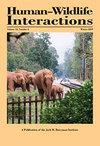Evaluation of the Impacts of Radio-Marking Devices on Feral Horses and Burros in a Captive Setting
IF 0.9
4区 环境科学与生态学
Q4 BIODIVERSITY CONSERVATION
引用次数: 8
Abstract
Radio-collars and other radio-marking devices have been invaluable tools for wildlife managers for >40 years. These marking devices have improved our understanding of wildlife spatial ecology and demographic parameters and provided new data facilitating model development for species conservation and management. Although these tools have been used on virtually all North American ungulates, their deployment on feral horses (Equus ferus caballus) or burros (E. asinus) has been limited. To determine if radio-collars and radio-tags could be safely deployed on feral equids, we conducted a 1-year observational study in 2015 to investigate fit and wear of radio-collars on feral horses and burros kept in pastures/pens at the Bureau of Land Management contracted adoption facility in Pauls Valley, Oklahoma, USA. We assessed the impact of radio-collars and transmitter tags on individual behavior, body condition, and evaluated neck surface for effects. We tested 2 radio-collar shapes (teardrop and oval) and a radio-tag (i.e., avian backpack) braided into the mane and tail of horses. Behavior of mares did not differ between radio-collared (n = 12) and control (uncollared; n = 12) individuals. Despite the small sample size, collared burro jennies (n = 4) spent more time standing than controls (n = 4). Stallions wearing radio-collars (n = 9) fed less, moved less, and stood more than controls (n = 8). During the study, we did not detect injuries to the necks of mares or burro jennies, but stallions developed small sores (that healed while still wearing radio-collars and re-haired within 3 months). Two radio-collars occasionally flipped forward over the ears onto the foreheads of stallions. Although our study confirmed that radio-collars could be safely deployed on captive mares and jennies, stallions proved challenging for a variety of reasons. While our conclusions were optimistic, longer studies will be required to ensure radio-collar safety on free-ranging feral horses and burros.无线电标记装置对圈养环境中野马和毛驴影响的评估
40多年来,无线电项圈和其他无线电标记设备一直是野生动物管理人员的宝贵工具。这些标记装置提高了我们对野生动物空间生态学和人口统计学参数的认识,为物种保护和管理模式的建立提供了新的数据。尽管这些工具已经在几乎所有的北美有蹄类动物身上使用过,但它们在野马(Equus ferus caballus)或驴子(E. asinus)身上的应用却很有限。为了确定无线电项圈和无线电标签是否可以安全地部署在野生马科动物身上,我们在2015年进行了一项为期一年的观察性研究,调查无线电项圈在美国俄克拉何马州保罗谷土地管理局承包收养设施的牧场/围栏中饲养的野马和驴子的佩戴情况。我们评估了无线电项圈和发射器标签对个体行为、身体状况的影响,并评估了颈部表面的影响。我们测试了两种无线电项圈形状(泪滴和椭圆形)和无线电标签(即鸟类背包)编织到马的鬃毛和尾巴。戴上无线电项圈(n = 12)和对照组(未戴项圈;N = 12)个体。尽管样样量小,戴项圈的驴子(n = 4)比对照组(n = 4)站立的时间更长。戴无线电项圈的种马(n = 9)比对照组(n = 8)进食更少,移动更少,站立时间更长。在研究期间,我们没有发现母马或驴子的颈部受伤,但种马出现了小溃疡(在戴无线电项圈时愈合,并在3个月内重新长毛)。两个无线电项圈偶尔会在种马的前额上向前翻转。虽然我们的研究证实,无线电项圈可以安全地部署在圈养的母马和珍妮身上,但由于各种原因,公马被证明具有挑战性。虽然我们的结论是乐观的,但还需要更长时间的研究来确保无线电项圈对自由放养的野马和驴子的安全性。
本文章由计算机程序翻译,如有差异,请以英文原文为准。
求助全文
约1分钟内获得全文
求助全文
来源期刊

Human–Wildlife Interactions
Environmental Science-Nature and Landscape Conservation
CiteScore
2.80
自引率
0.00%
发文量
0
审稿时长
11 weeks
期刊介绍:
Human–Wildlife Interactions (HWI) serves the professional needs of the wildlife biologist and manager in the arena of human–wildlife conflicts/interactions, wildlife damage management, and contemporary wildlife management. The intent of HWI is to publish original contributions on all aspects of contemporary wildlife management and human–wildlife interactions with an emphasis on scientific research and management case studies that identify and report innovative conservation strategies, technologies, tools, and partnerships that can enhance human–wildlife interactions by mitigating human–wildlife conflicts through direct and indirect management of wildlife and increased stakeholder engagement. Our intent is to promote a dialogue among wildlife professionals concerning contemporary management issues. As such, we hope to provide a repository for wildlife management science and case studies that document and share manager experiences and lessons learned.
 求助内容:
求助内容: 应助结果提醒方式:
应助结果提醒方式:


